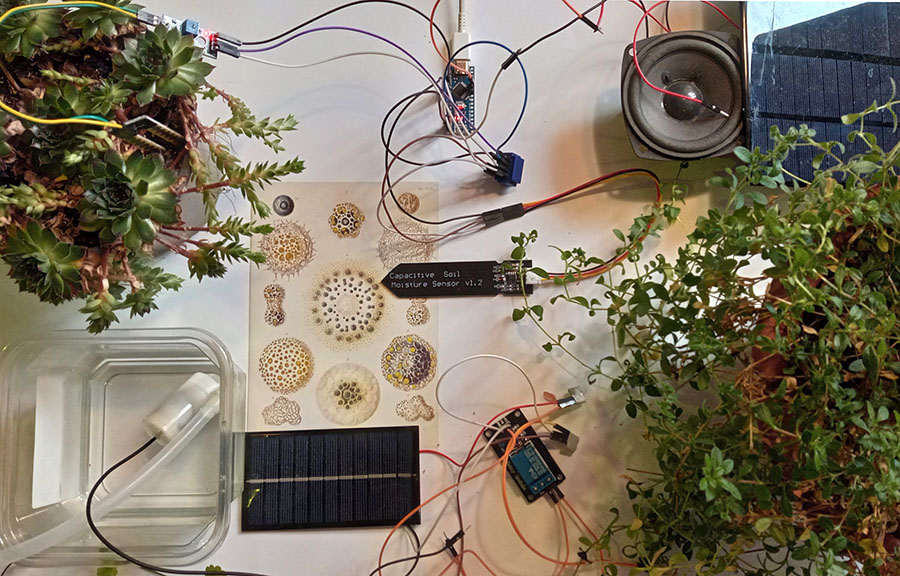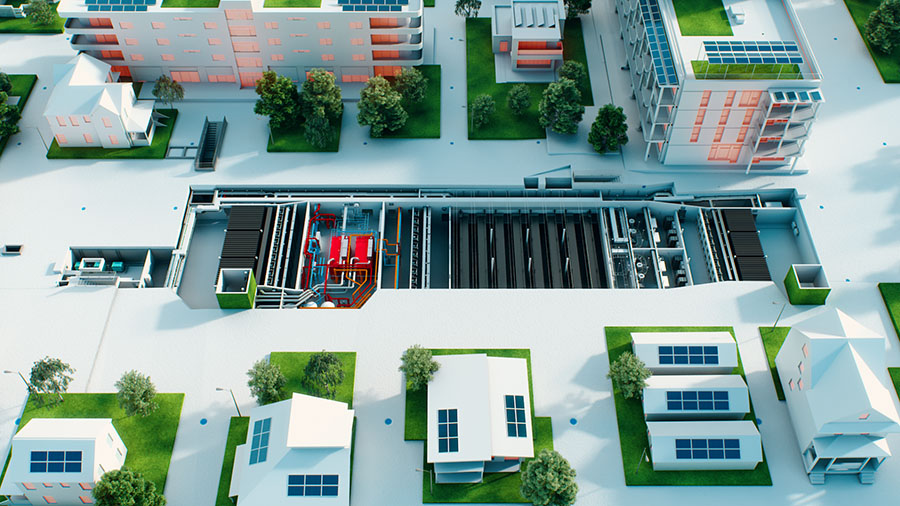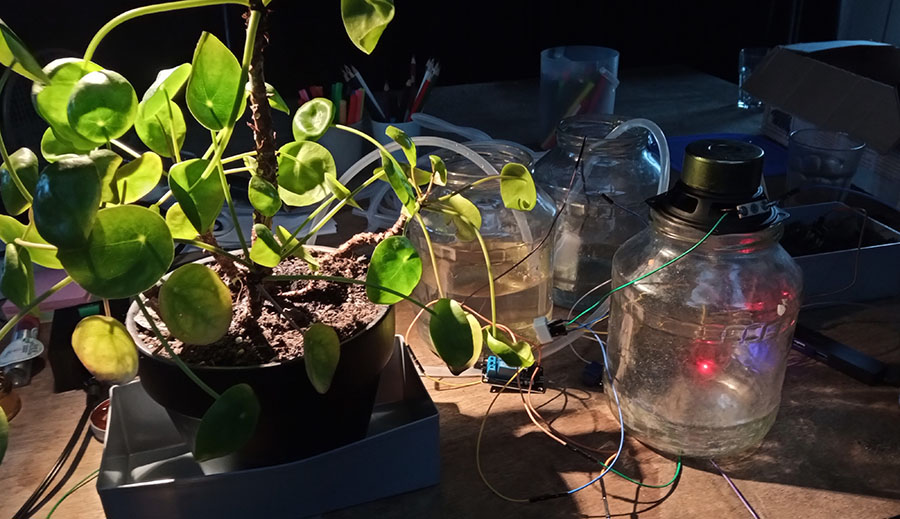
“I really feel that through this practice, I give myself constraints,” says Ola, “It actually makes me feel more empowered, gives me this agency, and actually I am being more mindful in a way, with how I live with technology.”
Artist researcher Ola Bonati is talking about permacomputing, a small and thriving community of practice inspired by permaculture, whose principles include “Care for life, Care for the chips”.
When we think about the sustainability of technology, the focus is often on the large and growing energy costs of running those technologies, both on our devices and in the cloud.
But focusing on usage ignores the bigger picture; an estimated 80 per cent of carbon emissions from our smartphones and laptops1 has already been emitted before we first use them, that is, from their manufacture. And for cloud computing, the “embedded” carbon in a data centre powered by renewable energy can be 50 per cent, or more2 .
The fact is our devices – in particular the CPUs, or Central Processing Units that drive them – are staggeringly energy, water and resource intensive to produce. And as there is no technical solution to those carbon emissions anywhere on the horizon, we urgently need to find other, more creative ways to address their impact.
That may seem fanciful in our always connected world, but there are companies, communities and networks who are finding practical ways to make that happen. There are no perfect answers here, but maybe some that can lead us in unexpected, and possibly more inspiring directions.
Getting circular with open source
“We’ve been thinking a lot about where hardware and software meet,” says Joseph P. De Veaugh-Geiss at KDE, “for example how we can align licensing of free and open-source software with the circular economy. The main things we focus on are the circular “Three R’s”: Reduce, Reuse, Recycle.“
KDE is the community that develops KDE apps, including the Plasma desktop, the main workspace you’ll find on Linux. Open source software has always been about creating practical workarounds to closed, resource-hungry and increasingly bloated platforms; it’s where functionality is generally valued over slickness.
And increasingly, the open source community is seeing deep overlaps between their software and sustainability. For KDE, so much so that sustainability is one of their three overarching goals for the next few years.
“Apple hardware is completely locked down and their software creates a dependency on the company, so independent software cannot be installed,” says Joseph “all of these restrictions follow an exclusively economic logic; there is no technological reason for this.”
But, adds Joseph, if devices are not completely locked down, free and open source projects can give them new life: “We can interrupt the e-waste cycle”.
In short, where manufacturers unilaterally “sunset” hardware, i.e render devices redundant by ending support, open-source software can extend a device’s life indefinitely.
Open source alternatives have been around for as long as the internet; indeed, much of it still holds the internet together. But over many years open source software has steadily lost ground to the relentless advance of “walled garden” digital platforms, optimised to the last pixel for a frictionless – and ultimately extractive – user experience. Regulators are starting to address this, but only partially, and progress seems slow.
“There’s been interest outside the Linux community,” says Joseph, “for many people there’s a lightbulb moment when they consider the material aspect of the devices they use. A lightbulb goes on, where they never thought about this before.”
Maybe as people tire of interminably pointless upgrades, perfectly good devices being turned into bricks, and the inescapable “enshittification” – as Cory Doctorow3 delicately puts it – of all things digital, open source may yet re-emerge as one of the best ways we have to reduce our tech’s ecological impact.
And as we take back control of our (not so new) devices, maybe we can also take back control of our online – and offline – lives too.
A repair and re-use culture for our not-quite-so-new devices is also at last starting to take root, online at places like www.ifixit.com and https://repair.eu/ , but also in many European cities, like Berlin where dozens of community repair workshops and cafes have spring up: https://www.berlin.de/adressen/repair-cafe/.
Joseph points to 2025 as a big year, as that’s when Microsoft stops supporting Windows 10, so 240 million PCs will become (seemingly) redundant overnight4.
If we can keep a good number of those computers working, we’ll not only be saving thousands of communities across the world from a Windows 10 e-waste tsunami, but also we’ll be reducing demand for a new generation of CPUs, which are always even more carbon intensive than the last.
But why exactly are CPUs so carbon intensive to produce in the first place?
It’s all in the chips
The research lab IMEC has conducted detailed research on the carbon emissions of “fabs”, as CPU factories are called. IMEC points to three main sources.
Firstly up to 40 per cent could be from gases emitted during manufacturing. These include sulfur hexafluoride, which is over 20,000 times more impactful than CO2. EMIC suggests these emissions could be mitigated by capturing and abatement technologies. But so far these technologies are hypothetical; to date no fab has plans to adopt them at scale.
Secondly, fabs use huge amounts of energy. TSMC, the world’s leading CPU producer, is based in uses over 7 per cent of Taiwan’s total energy5, where most of its fans are based. Most fabs locations, like Taiwan and South Korea, are still heavily coal dependent. Furthermore, making more advanced chips usually translates to increasingly complex processes, which leads to even more energy use; TSMC energy demand is expected to rise to 12.5 per cent of Taiwan’’s total by 2025.
The third source of carbon emissions are from the extraction, processing and supply of metals, rare earths and silicon that are needed to make every chip. Mining is inherently carbon intensive and ecologically destructive – there is little scope to reduce this.
CPU manufacture also requires vast amounts of water for cooling and industrial cleaning, and much of that water becomes contaminated. In Taiwan climate change is making this problem even worse; less typhoons now reach Taiwan, so TSMC trucks 15 million litres every day from North Taiwan to its fabs in the south, causing shortages for Taiwan’s rice farmers6.
When you add it all up there is no realistic pathway to producing sustainable CPUs anytime soon.
But instead of reducing our unquenchable demand for more and faster CPUs, companies and governments are heading in precisely the opposite direction, scrambling to invest hundreds of billions in new fabs often in places like Arizona and India, with energy and water shortages already7.
What we really need is to radically cut down our CPU habit; we need to stop making so many, and we need to squeeze as much life as we can out of the ones we have. Fortunately, it’s not just the open-source community looking at this, there are also business-focused tech companies who are thinking seriously about this too.
Greening the cloud
Swiss cloud provider Infomaniak has gone to impressive lengths to reduce their carbon impact. Its latest data centre is not only renewably powered, it uses filtered air instead of air conditioning, with the warm air heating 6,000 nearby homes. But once the carbon emissions from operations are minimised, further reductions have to come from the hardware.

“As we use renewable energy,” explains Thomas Jacobsen from Infomaniak, “and our data centres are cooled by natural outside air, our servers would have to operate for 7 to 10 years for them to emit the same amount of CO2 as that generated by their production. We’ve therefore decided to extend the life of our servers to 15 years.”
However, older servers are slower and less energy efficient, so after seven years Infomaniak’s servers are overhauled with replacement components including CPUs. Crucially, Infomaniak buys all those components second hand.
“By extending the life of our servers, we….avoid the emission of 174 tonnes of CO2 into the atmosphere per year,” says Thomas.
But there is a limit to how far data centres can go in reducing their carbon impact as Thomas readily admits: “It is only possible to reduce carbon emissions and energy consumption as much as possible. The cloud industry is still very polluting.”
As Thomas points out, there is currently no path to zero with offsetting, as many cloud providers claim: “offset projects are not capable of offsetting in one year the emissions generated in one year.”
Thomas also points to wider pressures on increasing data load: “The growing weight of data is mainly linked to usage and new quality standards set by the industry, such as 8K cameras and TVs.”
So if we want to go further in reducing our digital we may need to more radically rethink our relationship to technology, and even whether we need that technology in the first place.

Permacomputing: find, fix, tweak, hack, plug and play
This brings us back to the organically growing networks of permacomputing.
“The movement started with technology,” says Ola, and “a lot of artists or creators that are working on this intersection of permaculture, working with plants and mycelia, for example,”
“The goal is to create this idea that computation is just a part of the ecosystem,” adds Ola, “to make people aware that computing and devices and everything that we own is….created by us, but it’s been powered and built with natural resources.”
“This is very much the core of the thought behind permaculture, where you look at the ecosystem and you get informed by it and then that sort of shapes your practice as a farmer, right?”
Permacomputing advocates for a fundamental re-evaluation of our increasingly dysfunctional relationship with technology. Alongside reclaiming old devices and giving them new and often very different lives, permacomputing favours simpler, more minimal software that requires the minimum computation necessary to run.
For Ola one of the appeals of permacomputing is that it is not technically overwhelming by intention: “it can be artistic and it can be playful.“ she says, “Actually, the playfulness is very important for me because I don’t want to bash people over their heads with, like, how dare you buy a new device?”
And this sense of playful creativity can challenge our current technology orthodoxy, says Ola: “if you are only ever in…mainstream software, if you only ever use the programmes that are made to decrease friction, then you actually lose this sense of play. You lose the sense of, like, how can I be creative with this?”.

Permacomputing projects include networks of sensors and old processors to manage indoor gardens, there have been projects to revive Nintendo DS consoles from the 2000s, and there are also minimalist operating systems like Mu that can run on any x86 processor with a few lines of code.
Permacomputing is currently a small community, but as more people consider the true environmental costs of technology, they will surely also change the way they use technology; such as keeping devices alive for longer, and maybe even using technology significantly less.
This could have other benefits too. As Ola says, when she first started experimenting, permacomputing, “made me realise how dependent I am on, not only the objects, but also the software and how (permacomputing) can change this feeling of anxiousness”…….the anxiousness, that is, that more and more of us feel with the technologies we use, or in many ways, use us.
And it is at this intersection – at the environmental impact of the latest processors and their impact on our wellbeing – that permacomputing could have wider appeal. After all, if we can use older, slower devices, use them less, and more mindfully, we could have vastly less impact on the planet – and we may very well end up less anxious too.
Alistair Alexander writes, researches and leads projects that explore ecologies and technology in unusual and hopefully interesting ways. He currently teaches MA design students on these topics, and is working on a collaborative art project on technology that opens in June 2024 in Berlin. He recently co-wrote a paper on “Ecological Literacy and Technology Dystopias”, also to be published in June.
Find Alistair via https://reclaimed.systems , his newsletter or Mastodon.
Footnotes
- Just how bad is your phone for the planet — and what can you do about it? ↩︎
- Infomaniak sustainability report ↩︎
- The ‘Enshittification’ of TikTok ↩︎
- The end of Windows 10 support could turn 240 million PCs into e-waste ↩︎
- World’s largest chip foundry TSMC sets 2050 deadline to go carbon neutral ↩︎
- TSMC Using Water Tankers For Chip Production As 5nm Plant Faces Rationing ↩︎
- How much energy will new semiconductor factories burn through in the US? ↩︎
